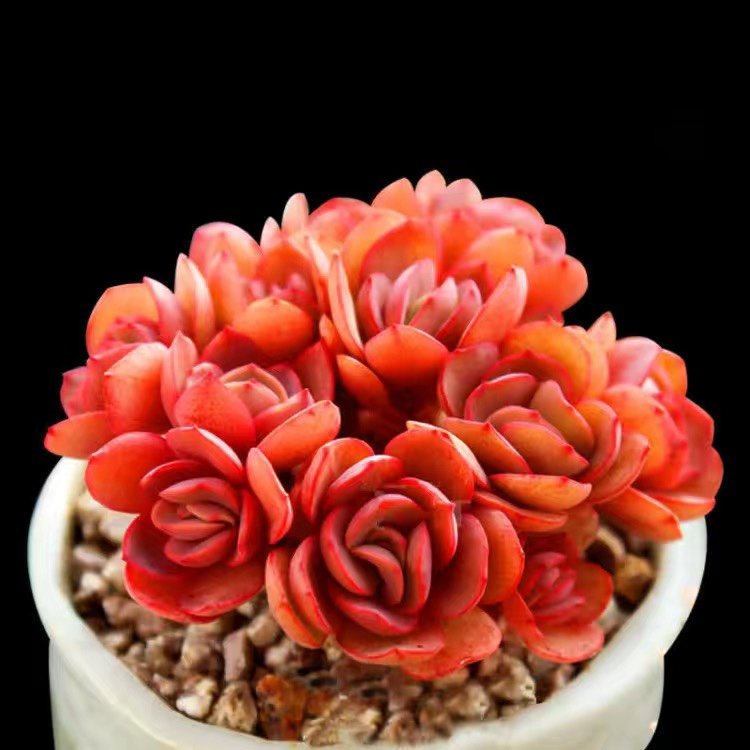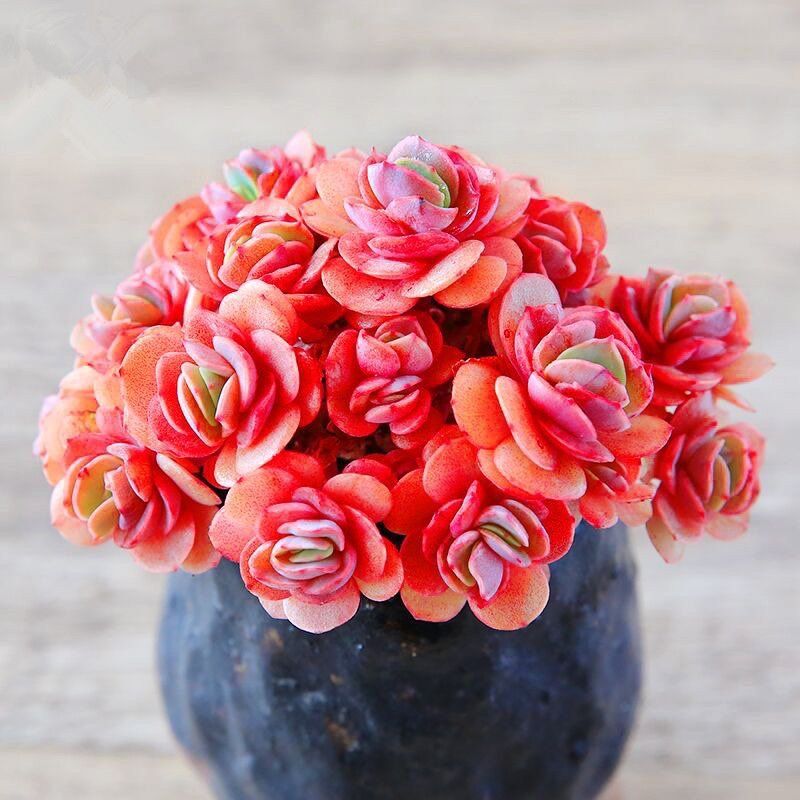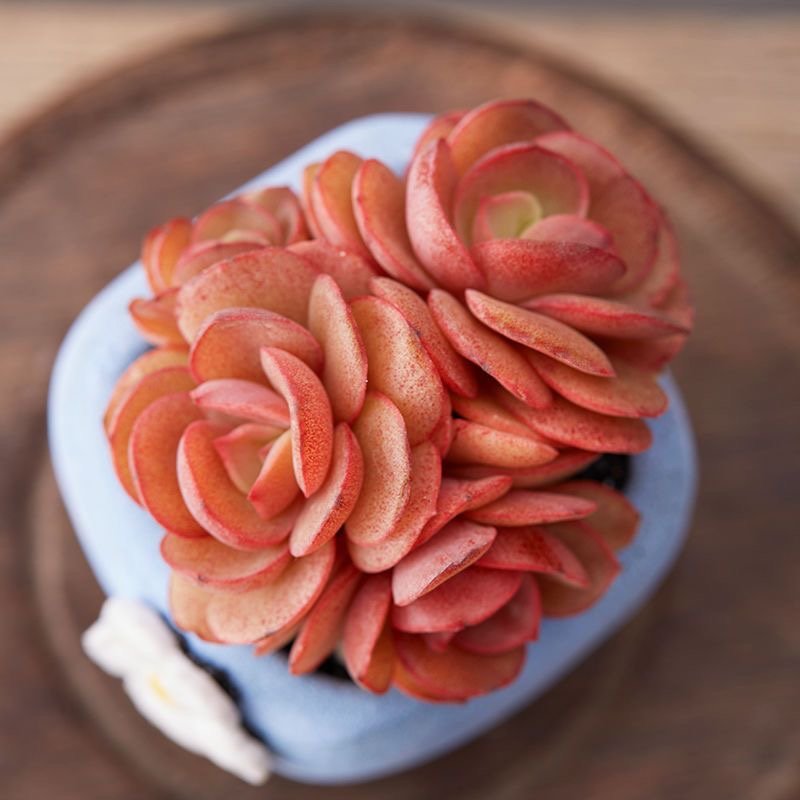
Echeveria sunyan is a special hybrid succulent. It was first found in Korea, in the Geumgwang area. People like this plant for its bright colors and small rosette shape. Many collectors want echeveria sunyan because it adds strong color to any group of plants. Each plant looks a little different, so every one is special. This succulent needs little care and grows well inside or outside. Gardeners pick this plant because it looks nice and is easy to take care of.
Key Takeaways
- Echeveria sunyan is a special Korean hybrid succulent. It has bright colors and a small, round rosette shape. The leaves can change color from gray-green to pink or red. This happens when the plant gets sunlight or cold. Each plant looks different and unique. Echeveria sunyan needs bright, direct sunlight to grow well. It also needs soil that drains water quickly. Water the plant only when the soil feels dry. Too much water can make the leaves yellow and mushy. This succulent is easy to care for inside or outside. It is a good plant for beginners and experts.
Echeveria Sunyan Overview
What Is Echeveria Sunyan
Echeveria sunyan is a hybrid succulent from Korea. Some people call it Echeveria Suyon. This plant is part of the Crassulaceae family and the Echeveria genus. Gardeners and collectors like echeveria sunyan because no one knows its parents. This makes the plant feel mysterious. It grows in small rosettes with leaves packed close together. Young plants are about 1.2 to 1.6 inches wide. Older rosettes can get as big as 5 inches across. Echeveria sunyan does not make flowers. Its colorful leaves are what people notice most.
Note: Echeveria sunyan is special because it is a unique hybrid and looks different from other succulents.
Here is a table that shows how echeveria sunyan fits with other succulents:
| Aspect | Details |
|---|---|
| Scientific Name | Echeveria ‘Suyon’ (synonym: Echeveria ‘Sunyan’) |
| Family | Crassulaceae |
| Subfamily | Sempervivoideae |
| Tribe | Sedeae |
| Genus | Echeveria |
| Origin | Popular Korean hybrid of unknown parentage |
| Growth Form | Compact rosettes with colorful, tightly-packed leaves |
| Rosette Size | Up to 5 inches (12 cm) diameter; usually 1.2 to 1.6 inches (3 to 4 cm) when young |
| Leaf Color | Gray-green with red margins; turns peachy pink to pinkish-red under stress |
| Flowering | Does not produce flowers |
Unique Features
Echeveria sunyan gets noticed for its bright colors and pretty look. The leaves start out gray-green and have red edges. If the plant gets a lot of sun or gets cold, the leaves can turn peachy pink or pinkish-red. This color change means each echeveria sunyan can look a bit different, even if they are the same kind.
Collectors and people who like plants enjoy this succulent for its beauty and how easy it is to use. Echeveria sunyan works well inside or outside. People put it in small pots or mix it with other succulents. Its small size and bright colors help it stand out in gardens and homes.
- Key features of echeveria sunyan:
- No one knows its parents, so it is special
- Small rosette shape with leaves close together
- Leaves change color when stressed
- No flowers, so leaves are the main part
- Many people use it to decorate homes and gardens
Echeveria sunyan is easy to spot in any group of plants. Its bright colors and simple care make it a favorite for both new and old plant fans.
Origin and Background

Korean Hybrid Roots
Echeveria sunyan is a hybrid succulent from Korea. Korean hybrids are known for special features. These plants have tight rosettes and thick leaves. The leaves can be green and pink. Sometimes, the edges of the leaves curl. Echeveria sunyan has these same traits. This makes it easy to spot.
No one knows which plants are its parents. This mystery makes the plant more interesting. Most Korean hybrids are easy to care for. They do not need much work. They grow well in sun or shade. These plants like soil that drains water fast. They can live in dry places. Many people think they are cheap and easy to find. They are easier to buy than some other hybrids.
Korean hybrid succulents are popular. They are easy to grow and look nice. Their colors and shapes attract many collectors.
Some main features of Korean hybrid succulents are:
- Rosettes that are tight and even
- Thick leaves with color changes
- Leaf edges that curl a little
- Easy to grow more and need little care
- Can live without much water and like sun
- Look nice and are not common everywhere
Echeveria sunyan is a good example of these plants. It has the best traits of Korean hybrids. It adds something new to any plant group.
Geumgwang Region
Echeveria sunyan comes from the Geumgwang region in Korea. This place is known for making special echeveria hybrids. Growers in Geumgwang use careful steps to make new plants. They want plants with new colors and shapes. Echeveria sunyan was first found here. People liked it right away because it looked so nice.
The weather in Geumgwang helps these plants grow well. Warm days and cool nights help the leaves get strong colors. The soil here lets water drain fast. This is good for succulents. Many collectors want plants from Geumgwang. They trust the plants from this area.
No one knows the parents of echeveria sunyan. This makes it more special. The hybrid shows how skilled Korean growers are. Each echeveria sunyan brings a part of Geumgwang’s plant story to homes everywhere.
Echeveria Sunyan Appearance

Rosette Shape
Echeveria sunyan grows in a tight rosette. The leaves form a circle, so it looks like a flower. Each rosette stays small and tidy. Young plants are tiny, but older ones can get up to five inches wide. This shape helps the plant get sunlight and save water. Many people like how even the rosette looks. That is why it is popular in gardens and collections.
The rosette shape makes echeveria sunyan look neat and clean. Gardeners pick this plant because it has a nice shape.
Leaf Colors
Echeveria sunyan leaves can show many colors. Most of the time, the leaves are gray-green. If the plant gets more sun or it gets cold, the edges turn red or pink. Some plants can even look peachy or pinkish-red. These color changes make each plant special. No two echeveria sunyan look the same. The thick leaves help the plant keep water when it is dry.
Here is a table that shows how the leaf color changes:
| Condition | Leaf Color |
|---|---|
| Normal | Gray-green |
| Bright Sunlight | Red or pink edges |
| Cold Temperatures | Peachy or pinkish-red |
Flower Colors
Echeveria sunyan does not grow flowers. This is different from many other succulents. People notice its leaves because they are bright and change color. You do not have to wait for flowers to enjoy this plant. Since there are no flowers, people look at the rosette and its colors.
- Main things about echeveria sunyan’s look:
- Tight, round rosette
- Leaves change color with light and cold
- No flowers, so leaves are what you see
Echeveria sunyan adds color and shape to any group of plants. Its look makes it a top pick for collectors and gardeners.
Echeveria Genus
Family and Classification
Echeveria sunyan is part of the echeveria genus. This group belongs to the Crassulaceae family. These plants are succulents with thick leaves and rosette shapes. Echeveria plants are easy to spot because of their special features. They grow close together and have fat, waxy leaves. The table below lists the main traits of echeveria plants that you can see in echeveria sunyan:
| Characteristic Category | Defining Traits of Echeveria Genus Present in Echeveria Sunyan |
|---|---|
| Growth Habit | Rosette form; compact, clumping or mounding; slow growth; perennial succulent herbaceous plant |
| Leaves | Fleshy, succulent, simple leaves arranged in rosettes; colors range from blue, gray, green, pink, purple, red, variegated; smooth, glossy, waxy texture; entire margins; leaf size approx. 3-6 inches; often with a powdery glaucous bloom |
| Stem | Succulent, green, round cross-section; covered with powdery bloom; erect growth with possible branching |
| Flowers | Tubular, bell- or star-shaped; colors include gold/yellow, orange, pink; bloom in spring and summer; showy; attract pollinators like bumble bees and hummingbirds; flower size under 1 inch; inflorescence types include cyme and raceme |
| Cultural Preferences | Full sun to partial shade; well-draining soil (loam, sand); drought tolerant; low maintenance |
| Ecological Value | Attracts pollinators such as bees, hummingbirds; non-toxic |
| Size | Height ranges from 1 inch to 1 foot; width up to 1 foot |
The name “echeveria” comes from Atanasio Echeverría y Godoy. He was a plant artist from Mexico in the 1700s. His drawings helped people learn about Mexican plants. A French scientist named the genus after him. Echeverría’s art still helps people study plants today.
The name “echeveria” honors Echeverría and his work with plants.
Native Regions
Most echeveria plants grow in dry places in Central America and Mexico. Some also come from northwestern South America. These areas are sunny and do not get much rain. The plants live in rocky ground and need little water. Echeveria sunyan is different because it was made in Korea. This makes it special compared to other echeveria plants. Its Korean roots show that new hybrids can come from outside the usual places.
Echeveria Sunyan Care
Care Basics
Echeveria sunyan needs special care to grow well. This plant loves sunlight and does best near a south-facing window. Place the plant less than one foot from the window to give it enough light. Sunlight helps the leaves keep their bright colors. Without enough sunlight, the plant may lose its color and look dull.
Water needs for echeveria sunyan are low. The plant likes dry soil. Water about half a cup every twelve days if the plant is not in direct sunlight and sits in a five-inch pot. Always check that the soil is dry before watering again. Too much water can cause the leaves to turn yellow and mushy.
Soil is important for this plant. Echeveria sunyan grows best in soil that drains very well. Mix perlite or vermiculite into cactus soil to help water drain fast. Good drainage keeps the roots healthy and stops root rot.
Here is a table with the main care needs:
| Care Aspect | Requirement |
|---|---|
| Light | Place less than 1ft from a south-facing window; needs bright, direct sunlight; does not tolerate low light |
| Water | 0.5 cups every 12 days, especially when not in direct sunlight and potted in a 5″ pot |
| Soil | Must drain very well and not retain moisture; mix perlite or vermiculite into cactus soil |
How to Care for Echeveria Sunyan
Echeveria sunyan grows best in temperatures between 60°F and 85°F. Keep the plant away from cold drafts and heaters. Temperatures below 55°F can harm the plant. During hot weather, give the plant some shade to protect it from strong sunlight.
Common mistakes in care include overwatering, using the wrong soil, and giving too little or too much sunlight. Overwatering causes yellow, soft leaves. Underwatering makes the leaves wrinkled and thin. Use loose, airy soil and pots with drainage holes. Watch for pests like spider mites and mealybugs. These pests can damage the plant. Remove them with neem oil or insecticidal soap.
To avoid disease, keep the leaves dry and make sure air can move around the plant. Prune any damaged leaves with clean tools. Quarantine new plants before adding them to a collection.
Tip: Monitor leaf color and shape to spot problems early. Adjust care as needed for healthy growth.
Echeveria sunyan needs bright sunlight, dry soil, and careful watering. With the right care, this plant will stay colorful and healthy.
Echeveria sunyan is a Korean hybrid. No one knows its parents. It has bright colors and a small, round shape. Many people who like plants notice it right away. Collectors like echeveria sunyan because it looks different. It is also simple to care for. This succulent gives a new look to plant groups.
Lots of gardeners like to find new hybrids. Echeveria sunyan lets them add something special to their home or garden.
FAQ
How big does Echeveria Sunyan grow?
Echeveria Sunyan can get as wide as 5 inches. When it is young, it stays much smaller, about 1.2 to 1.6 inches across. The plant keeps its round, tight shape as it gets older.
Does Echeveria Sunyan need direct sunlight?
Echeveria Sunyan likes lots of bright, direct sunlight. Putting it by a south-facing window helps its colors stay bright. If it does not get enough light, the leaves can lose their bright colors.
Why do the leaves change color?
The leaves change color when the plant gets more sun or when it gets cold. These things can make the gray-green leaves turn pink, red, or peachy. The plant changes color because it is stressed.
Can Echeveria Sunyan survive indoors?
Yes, Echeveria Sunyan can live indoors. It needs a bright spot and soil that drains water well. If you care for it, the plant will stay healthy and keep its colors.
What should someone do if the leaves turn yellow and mushy?
Yellow, mushy leaves usually mean you watered too much. Wait for the soil to dry before watering again. Take off any bad leaves so the plant can get better.